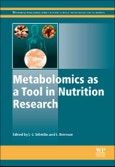Metabolomics is a multidisciplinary science used to understand the ways in which nutrients from food are used in the body and how this can be optimised and targeted at specific nutritional needs. Metabolomics as a Tool in Nutrition Research provides a review of the uses of metabolomics in nutritional research. Chapters cover the most important aspects of the topic such as analysis techniques, bioinformatics and integration with other 'omic' sciences such as proteomics and genomics. The final chapters look at the impact of exercise on metabolomic profiles and future trends in metabolomics for nutrition research.
Please Note: This is an On Demand product, delivery may take up to 11 working days after payment has been received.
Table of Contents
- List of contributors
- Woodhead Publishing Series in Food Science, Technology and Nutrition
- Preface
- Part One: Principles
- 1. Challenges in nutritional metabolomics: from experimental design to interpretation of data sets
- Abstract
- 1.1 Introduction
- 1.2 The experimental design
- 1.3 The analytical platform
- 1.4 Extraction of data sets and statistical analyses
- 1.5 Metabolite identification
- 1.6 Biological interpretations
- 1.7 Conclusion: do we need standardisation procedures and repositories?
- 2. Metabolic profiling as a tool in nutritional research: key methodological issues
- Abstract
- 2.1 Introduction
- 2.2 Key issues in nutritional research
- 2.3 The role of genomics, proteomics, metabolomics, and metagenomics in nutritional research
- 2.4 Applications of metabolomics in nutrition-related research
- 2.5 The use of metabolomics to assess the effects of diet on health
- 2.6 Methods for mapping dietary patterns
- 2.7 Observational and interventional studies into the effects of diet and nutrition on health
- 2.8 Analytical methods
- 2.9 Issues in analysing samples
- 3. Chemometrics methods for the analysis of genomics, transcriptomics, proteomics, metabolomics, and metagenomics datasets
- Abstract
- 3.1 Introduction
- 3.2 Unsupervised and supervised pattern recognition methods
- 3.3 Multivariate calibration methods for developing predictive models
- 3.4 Statistical data integration methods
- 3.5 Data integration: multiblock strategies
- 3.6 Data integration: calibration transfer methods
- 3.7 Data integration: multiway/multimodal analysis methods
- 3.8 Data integration: correlation-based approaches
- 3.9 Data integration: techniques for analysing different types of genomics datasets
- 3.10 Statistical data integration of different sample types
- 3.11 Statistical data integration of different molecular components in samples
- 3.12 Modelling relationships between molecular components
- 3.13 Conclusion and future trends
- 1. Challenges in nutritional metabolomics: from experimental design to interpretation of data sets
- Part Two: Applications in nutrition research
- 4. Application of lipidomics in nutrition research
- Abstract
- Acknowledgement
- 4.1 Introduction
- 4.2 Lipids
- 4.3 Lipidomics
- 4.4 Lipidomics in nutrition research
- 4.5 Conclusion and future trends
- 5. Analysing human metabolic networks using metabolomics: understanding the impact of diet on health
- Abstract
- Acknowledgements
- 5.1 Introduction
- 5.2 Metabolic network reconstruction
- 5.3 Human metabolic networks
- 5.4 Linking metabolomics data and metabolic network elements
- 5.5 Metabolism modelling, from pathways to network
- 5.6 Subnetwork extraction between identified metabolites
- 5.7 Conclusion and future directions
- 6. Using metabolomics to analyse the role of gut microbiota in nutrition and disease
- Abstract
- 6.1 Introduction: gut microbiota and human health
- 6.2 Metagenomics of gut microbiota
- 6.3 Metabolomics: uncovering complex host-microbe interactions
- 6.4 The marriage of metagenomics and metabolomics: microbiome-metabolome interactions
- 6.5 Future perspectives: personalised nutrition
- 7. Metabotyping: moving towards personalised nutrition
- Abstract
- 7.1 Introduction
- 7.2 The concept of the metabotype
- 7.3 Examples of metabotyping with a focus on nutrition
- 7.4 Extension of metabotypes to include markers of dietary origin
- 7.5 Conclusion and future trends
- 7.6 Sources of further information and advice
- 8. Using metabolomics to identify biomarkers for metabolic diseases: analytical methods and applications
- Abstract
- 8.1 Introduction
- 8.2 Using metabolomics to understand the relationship between nutrition and chronic metabolic diseases
- 8.3 Cohort studies and biomarker identification
- 8.4 Isolating in situ biomarkers
- 8.5 Conclusions and future trends
- 9. Using metabolomics to evaluate food intake: applications in nutritional epidemiology
- Abstract
- 9.1 Introduction
- 9.2 Biomarkers as a complementary approach to questionnaires
- 9.3 Definition of the food metabolome
- 9.4 Metabolomics as a tool for dietary biomarker discovery
- 9.5 Dietary patterns and metabolomic profiles: potential use of nutritypes
- 9.6 Validation of putative biomarkers
- 9.7 The future of metabolomics in dietary assessment
- 9.8 Conclusion
- 10. Metabolomics and nutritional challenge tests: what can we learn?
- Abstract
- 10.1 Introduction
- 10.2 Application of metabolomics to challenge tests
- 10.3 Conclusion and future trends
- 11. Using metabolomics to describe food in detail
- Abstract
- 11.1 Introduction
- 11.2 Using metabolomics to assess the effects of genetic selection and modification
- 11.3 Using metabolomics to assess the effects of organic versus conventional farming
- 11.4 Using metabolomics to identify the geographical origin of food products
- 11.5 Using metabolomics to assess the effects of rearing conditions on the quality of meat, eggs, and fish
- 11.6 Using metabolomics to assess the effects of processing on food quality
- 11.7 Using metabolomics to assess the effects of digestion on nutrient intake from particular foods
- 11.8 Conclusion
- Appendix: abbreviations
- 12. Future perspectives for metabolomics in nutrition research: a nutritionist's view
- Abstract
- 12.1 Introduction
- 12.2 Metabolites identification and biological relevance
- 12.3 In vivo metabolomics
- 12.4 Conclusion
- 4. Application of lipidomics in nutrition research
- Index








